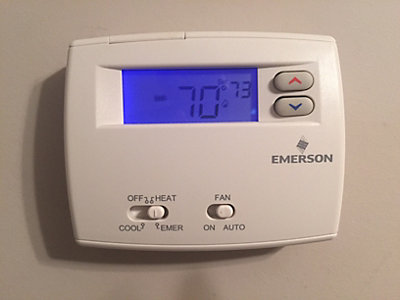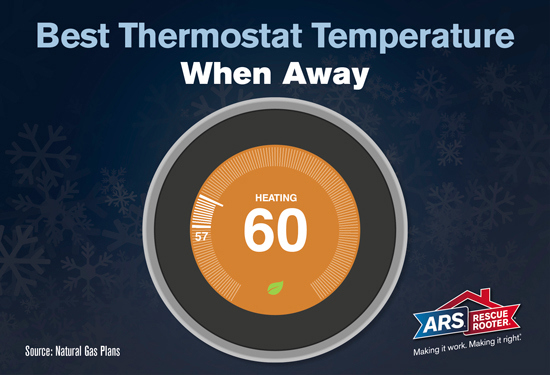Check Best Thermostat Pricing in Amazon
** As an Amazon Associate, I earn from qualifying purchases.
For optimal comfort and energy savings, set your thermostat between 68°F and 72°F during the winter. This range keeps your home warm while managing heating costs.
Winter brings chilly weather, making indoor warmth crucial. Knowing the right thermostat setting can save money and keep you cozy. Balancing comfort and energy efficiency is key. Many factors, like home size and insulation, affect the ideal temperature. In this blog, we’ll explore the best thermostat settings for winter.
We’ll also provide tips to help you stay warm and reduce energy bills. Understanding these settings can make a big difference in your comfort and budget. Stay tuned to learn how to keep your home just right this winter.

Credit: www.ars.com
Optimal Winter Temperature
Finding the optimal winter temperature for your home can be challenging. You want to stay warm while keeping energy bills low. Setting your thermostat correctly helps achieve both. Let’s explore the best temperature settings and how to maintain energy efficiency.
Recommended Settings
Experts suggest setting your thermostat to 68°F during the day. This temperature keeps you warm without using too much energy. At night, lowering the thermostat to 60°F is ideal. You can stay comfortable by using warm blankets.
For those who are home during the day, 68°F is still the best choice. If the house is empty, set the thermostat to 60°F or lower. Programmable thermostats can help manage these changes easily.
Energy Efficiency
Maintaining energy efficiency in winter is crucial. Lowering your thermostat by 7-10°F for eight hours a day can save up to 10% a year on heating. Use a programmable thermostat for automatic adjustments. Ensure your home is well-insulated to keep the heat inside.
Seal any drafts around windows and doors. Use heavy curtains to reduce heat loss. Regular maintenance of your heating system also helps. Clean filters and check for any issues. These steps ensure your system runs efficiently, saving energy and money.
Factors Affecting Thermostat Settings
Setting the right thermostat temperature in winter can be tricky. Several factors influence this decision. Home insulation and personal comfort are two key considerations.
Home Insulation
Home insulation plays a crucial role in thermostat settings. Well-insulated homes retain heat better. This means you can set the thermostat lower. Poorly insulated homes lose heat quickly. You may need to set the thermostat higher. Check your windows and doors for drafts. Proper insulation can save energy and money.
Personal Comfort
Personal comfort varies from person to person. Some people prefer warmer indoor temperatures. Others find cooler environments more comfortable. It’s important to find a balance. Consider wearing layers to adjust your comfort level. Use blankets and warm clothing to stay cozy. Remember, personal comfort impacts your thermostat setting.
Thermostat Types
When winter rolls in, managing your home’s temperature becomes essential for comfort and energy efficiency. One crucial factor is the type of thermostat you use. Let’s dive into the differences between manual and smart thermostats to help you decide which suits your needs best.
Manual Thermostats
Manual thermostats are straightforward and easy to use. You set the temperature you want, and it stays there until you change it. This can be great if you like keeping things simple.
However, manual thermostats can lead to higher energy bills if you forget to adjust them when you leave home or go to bed. Imagine leaving for work and forgetting to turn down the heat. You’d be heating an empty house all day!
Many people find the simplicity of manual thermostats appealing. But if you’re looking for more control and energy savings, you might want to consider a smart thermostat.
Smart Thermostats
Smart thermostats offer more features and flexibility. They can learn your schedule and adjust the temperature automatically. This means you can wake up to a warm house and come home to a cozy environment without touching the thermostat.
Smart thermostats can also be controlled remotely via smartphone apps. If you’re on vacation and realize you left the heat on, you can adjust it from anywhere. This can save you a lot of money and hassle.
Some models even provide energy usage reports and tips to help you save more. They can detect when you’re home or away and adjust the temperature accordingly. This makes them a great choice if you’re looking to balance comfort and energy efficiency.
So, what type of thermostat do you have in your home? Would a smart thermostat make your life easier and more efficient? Consider your habits and needs to make the best choice for your winter comfort.

Credit: plumblineservices.com
Cost-saving Strategies
Winter can bring high heating costs, but you can save money. Use smart strategies to keep your home warm without breaking the bank. Here are some effective tips.
Temperature Adjustments
Adjusting your thermostat can save a lot of money. Set it to 68°F during the day when you are at home. Lower it by 10-15 degrees at night or when you are away. This can reduce your heating bill significantly. Every degree you lower can save about 1% on your bill.
Alternative Heating Methods
Use alternative heating methods to reduce costs. Space heaters can warm small areas without heating the entire house. Close off unused rooms to direct heat where it is needed. Use thick curtains to keep the heat inside. Seal drafts around windows and doors with weather stripping or caulking.
Consider using ceiling fans to circulate warm air. Set the fan to run clockwise. This pushes warm air down from the ceiling. It can make your rooms feel warmer. Layer up with warm clothing and use extra blankets. These small changes can make a big difference in your heating costs.
Health Considerations
Setting your thermostat in the winter involves more than just comfort—it’s also about your health. Keeping your home at the right temperature can impact your well-being in several ways. Let’s explore some health considerations you should keep in mind.
Indoor Air Quality
Did you know that indoor air quality can affect your health? In winter, people tend to keep windows closed to preserve heat. This can lead to a buildup of indoor pollutants. Dust, pet dander, and mold thrive in warm, enclosed spaces.
When you set your thermostat, think about how it impacts air quality. A temperature that’s too high can exacerbate these issues. Use air purifiers and regularly clean filters to keep the air clean. You might be surprised at how much better you’ll feel.
Humidity Control
Humidity levels can drop in the winter, making the air in your home dry. Dry air can lead to problems like dry skin, irritated eyes, and respiratory issues. When you set your thermostat, consider how it affects humidity.
Check Best Thermostat Pricing in Amazon
** As an Amazon Associate, I earn from qualifying purchases.
A good humidity level is between 30-50%. You can use a humidifier to maintain this range. Running one alongside your heating system can make a big difference. Your skin will thank you, and you’ll breathe easier.
What temperature do you find most comfortable in the winter? Have you noticed any changes in your health based on your thermostat settings? Share your thoughts and experiences.
Common Mistakes To Avoid
During the winter months, managing your thermostat settings can be tricky. Many people make common mistakes that lead to higher energy bills and discomfort. Here, we will explore some frequent errors to avoid.
Overheating
Setting your thermostat too high can cause overheating. This leads to wasted energy and higher bills. Aim for a comfortable, not overly warm, home. Most experts suggest 68°F during the day. Lower it at night or when you’re away to save energy.
Ignoring Maintenance
Regular maintenance of your heating system is crucial. Dirty filters and blocked vents reduce efficiency. This forces your system to work harder, raising your energy costs. Schedule routine inspections and cleanings to keep your system in top shape.
Expert Recommendations
Setting your thermostat at the right temperature during winter can be tricky. Expert recommendations can help ensure comfort, efficiency, and cost savings. Below, we delve into professional advice and seasonal adjustments that can make all the difference in your home this winter.
Professional Advice
Experts suggest keeping your thermostat at around 68°F during the day when you are home. This temperature is comfortable for most people and helps manage energy costs. At night or when you’re away, lowering it to 60-62°F can save you even more.
Do you have programmable thermostats? They can automatically adjust temperatures based on your schedule. This way, you don’t have to remember to change settings manually. It’s a small change that can lead to significant savings.
Seasonal Adjustments
In winter, layering up can help you stay warm without cranking up the heat. Wear sweaters and use blankets. This reduces the need for higher thermostat settings.
Have you considered using space heaters in frequently used rooms? This can help maintain comfort without heating the entire house. Just be cautious with their use to avoid safety hazards.
Sealing drafts and insulating your home also play a critical role. Poor insulation can cause heat loss, making your thermostat work harder. Inspect your windows and doors for leaks and seal them to keep the warmth inside.
What are your strategies for staying warm and energy-efficient during the winter? Share your tips in the comments below. Your insights can help others find effective solutions for their homes.
Thermostat Maintenance
Keeping your thermostat well-maintained during the winter is crucial for ensuring your home stays warm and your energy bills stay low. Neglecting thermostat maintenance can lead to inefficiencies and higher costs. Let’s dive into some key areas of thermostat maintenance that you should focus on.
Regular Checkups
Regular checkups are essential for keeping your thermostat in good working order. Schedule a professional inspection at least once a year.
This can help spot any issues before they become significant problems. A well-maintained thermostat helps maintain a consistent temperature in your home.
Have you ever noticed your home feeling colder than usual even though you set the thermostat? A quick checkup might reveal the culprit.
Troubleshooting Tips
Troubleshooting your thermostat can save you from a cold night. Check the batteries if your thermostat is not working correctly.
A simple battery replacement can often fix the issue. Make sure to keep a few spare batteries at home.
If the display is blank or the thermostat is unresponsive, it might be time to call a professional. Sometimes, a quick reset can also solve minor glitches.
Maintaining your thermostat doesn’t have to be a hassle. Regular checkups and simple troubleshooting can go a long way in ensuring your home stays warm and cozy all winter long.

Credit: www.ars.com
Frequently Asked Questions
Is 72 Too High For A Thermostat In Winter?
Setting your thermostat to 72°F in winter is a personal choice. It offers comfort but may increase energy costs. Many experts recommend 68°F for better energy efficiency.
What Is The Best Setting For Your Thermostat In The Winter?
Set your thermostat to 68°F (20°C) during the day for optimal comfort and energy savings in winter. Lower it at night.
What Temperature To Keep A House In Winter To Save Money?
Set your thermostat to 68°F (20°C) during the day and lower it at night to save money in winter.
Is 72 Cold In Winter?
No, 72 degrees Fahrenheit is not cold in winter. It’s a comfortable indoor temperature.
Conclusion
Keeping your thermostat at an ideal temperature can save energy and money. Aim for a setting around 68 degrees Fahrenheit during the day. Lower it slightly at night or when you’re away. This balance keeps your home cozy without high heating costs.
Experiment with small adjustments to find your comfort zone. Use blankets or wear layers to stay warm. Simple changes make a big difference. Stay warm, save money, and enjoy a comfortable winter season.
Check Best Thermostat Pricing in Amazon
** As an Amazon Associate, I earn from qualifying purchases.

